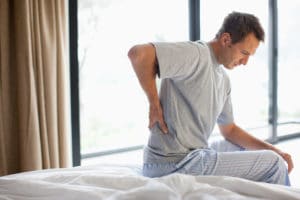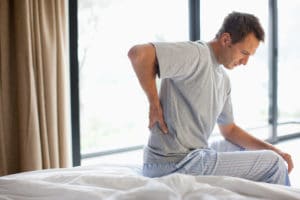
The spinal discs can tear and even leak. This can happen for several reasons. Most commonly, there is a traumatic injury somewhere in the past, either recently or several years before the onset of chronic pain. Degenerative disc disease is also often seen as a person gets older, which has led researchers to believe that aging and normal wear and tear is also a contributing factor in degenerative disc disease.
Whatever the originating cause, degenerative disc disease has telltale characteristics, and also telltale signs. A torn and worn-down disc may flatten out or bulge off to one side. In that case, the nerve roots that travel through that small segment of the spine get compressed or impinged. The pressure on the nerve leads to symptoms such as:
- Intense pain that comes and goes.
- Pain may get better when lying down.
- Localized pain in a particular part of the back and feels worse when you twist, bend, stand, or sit.
- Pain is accompanied by tingling or numbness in the legs.
Lumbar Degenerative Disc Disease Treatment
One of the biggest questions patients have is if they will need surgery for their chronic or acute low back pain. This isn’t always the case. Though there are a few exceptions, such as an acute traumatic injury or diagnosis of a severely worn disc, many of the patients who present with low back pain are treated non-surgically at the onset of care. Physical therapy and injections of corticosteroid medication can relieve inflammation and discomfort.
Lumbar spinal surgery is considered when symptoms do not improve with more conservative measures. Patients of Princeton Neurological Surgery can expect to receive exceptional care from Dr. Lipani based on years of training and experience, including a Fellowship in Complex Neuro-Spine Surgery.
Schedule a Consultation
To discuss treatment options for chronic low back pain with Dr. Lipani, call to schedule a consultation at our Princeton, Somerset, or Morristown office.


